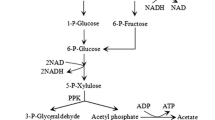Abstract
A gene encoding mannitol-2-dehydrogenase (E.C. 1.1.1.138) (MDH) was cloned from Lactobacillus reuteri and expressed in Escherichia coli. The 1,008-bp gene encodes a protein consisting of 336 amino acids, with a predicted molecular mass of 35,920 Da. The deduced amino acid sequence of L. reuteri MDH (LRMDH) is 77% and 76% similar to the MDHs from Leuconostoc mesenteroides and Leuconostoc pseudomesenteroides, respectively. The purified recombinant enzyme appears as a single band of 40 kDa in sodium dodecyl sulfate-polyacrylamide gel electrophoresis, but gel filtration indicates that the native enzyme is a dimer. The optimum temperature for the recombinant enzyme is 37°C, the pH optima for D-fructose reduction and D-mannitol oxidation are 5.4 and 6.2, respectively. The Km values for NAD (9 mM) and NADH (0.24 mM) are significantly higher than those for NADP (0.35 mM) and NADPH (0.04 mM). The Km values of LRMDH for D-fructose and D-mannitol are 34 mM and 54 mM, respectively. Contrary to what the enzyme sequence suggests, recombinant LRMDH contains a single catalytic zinc per subunit.



Similar content being viewed by others
References
Aarnikunnas J, Rönnholm K, Palva A (2002) The mannitol dehydrogenase gene (mdh) from Leuconostoc mesenteroides is distinct from other known bacterial mdh genes. Appl Microbiol Biotechnol 59:665–671
Ausubel FM, Brent R, Kingston RE, Moore DD, Seidman JG, Smith JA, Struhl K (eds) (1994) In: Current protocols in molecular biology. Wiley, New York
Bradford MM (1976) A rapid and sensitive method for the quantitation of microgram quantities of protein utilizing the principles of protein-dye binding. Anal Biochem 72:248–254
Burdette DS, Secundo F, Phillips RS, Dong J, Scott RA, Zeikus JG (1997) Biophysical and mutagenic analysis of Thermoanaerobacter ethanolicus secondary alcohol dehydrogenase activity and specificity. Biochem J 326:717–724
Hahn G, Kaup B, Bringer-Meyer S, Sahm H (2003) A zinc-containing mannitol dehydrogenase from Leuconostoc pseudomesenteroides ATCC 12291: purification of the enzyme and cloning of the gene. Arch Microbiol 179:101–107
Hunt JB, Neece SH, Ginsburg A (1984) The use of 4-(2-pyridylazo) resorcinol in studies of zinc release from Escherichia coli aspartate transcarbamoylase. Anal Biochem 146:150–157
Hattori K, Suzuki T (1973) Large scale production of erythritol and its conversion to D-mannitol production by n-alkane-grown Candida zeylanoides. Agric Biol Chem 38:1203–1208
Kaup B, Bringer-Meyer S, Sahm H (2004) Metabolic engineering of Escherichia coli: construction of an efficient biocatalyst for d-mannitol formation in a whole-cell biotransformation. Appl Microbiol Biotechnol 64:333–339
Korakli M, Vogel RF (2003) Purification and characterization of mannitol dehydrogenase from Lactobacillus sanfranciscensis. FEMS Microbiol Lett 220:281–286
Laemmli UK (1970) Cleavage of structural proteins during the assembly of the head of bacteriophage T4. Nature (London) 227:680–685
Martinez G, Barker A, Horecker BL (1963) A specific mannitol dehydrogenase from Lactobacillus brevis. J Biol Chem 238:1598–1603
Nordling E, Jornvall H, Persson B (2002) Medium-chain dehydrogenases/reductases (MDR). Family characterizations including genome comparisons and active site modeling. Eur J Biochem 269:4267–4276
Onishi H, Suzuki T (1970) Microbial production of D-mannitol and D-fructose from glycerol. Biotechnol Bioeng 12:913–920
Rodriguez E, A J, Rodriguez R, Nunez M, Medina M (2003) Reuterin production by lactobacilli isolated from pig faeces and evaluation of probiotic traits. Lett Appl Microbiol 37:259–63
Saha BC (2004) Purification and characterization of a novel mannitol dehydrogenase from Lactobacillus intermedius. Biotechnol Prog 20:537–542
Salou P, Loubiere P, Pareilleux A (1994) Growth and energetics of Leuconostoc oenos during cometabolism of glucose with citrate or fructose. Appl Environ Microbiol 60:1459–1466
Schneider KH, Giffhorn F (1989) Purification and properties of a polyol dehydrogenase from the phototrophic bacterium Rhodobacter sphaeroides. Eur J Biochem 184:15–19
Schneider KH, Giffhorn F, Kaplan S (1993) Cloning, nucleotide sequence and characterization of a mannitol dehydrogenase gene from Rhodobacter sphaeroides. J Gen Microbiol 139:2475–2484
Slatner M, Nidetzky B, Kulbe KD (1999) Kinetic studies of catalytic mechanism of mannitol dehydrogenase from Pseudomonas fluorescens. Biochemistry 38:10489–10498
Slatner M, Nagl G, Haltrich D, Kulbe KD, Nidetzky B (1998) Enzymatic production of pure D-mannitol at high productivity. Biocatal Biotransform 16:351–363
Soetaert W, Buchholz K, Vandamme EJ (1995) Production of D-mannitol and D-lactic acid by fermentation with Leuconostoc mesenteroides. Agro Food Industry Hi-tech 6:41–44
Stoop JM, Mooibroeck H (1998) Cloning and characterization of NADP+-mannnitol dehydrogenase cDNA from the button mushroom Agaricus bisporus, and its expression in response to NaCl stress. Appl Environ Microbiol 64:4689–4696
Vallee B L, Auld DS (1990) Zinc coordination, function, structure of zinc enzymes and other proteins. Biochemistry 29:5648–5659
Von Weymarn N, Hujanen M, Leisola M (2002) Production of d-mannitol by heterofermentative lactic acid bacteria. Process Biochem 37:1207–1213
Wisniak J, Simon R (1979) Hydrogenation of glucose, fructose, and their mixtures. Ind Eng Chem Prod Res Dev 18:50–57
Wisselink HW, Weusthuis RA, Eggink G, Hugenholtz J, Grobben GJ (2002) Mannitol production by lactic acid bacteria: a review. Int Dairy J 12:151–161
Woodyer R, van der Donk W, Zhao H (2003) Relaxing the nicotinamide cofactor specificity of phosphite dehydrogenase by rational design. Biochemistry 42:11604–11614
Acknowledgements
We thank the FINE Company (Osaka, Japan) for financial assistance to Y. Sasaki. We are grateful to Dr. C. Vieille for helpful discussions and valuable suggestions
Author information
Authors and Affiliations
Corresponding author
Rights and permissions
About this article
Cite this article
Sasaki, Y., Laivenieks, M. & Zeikus, J.G. Lactobacillus reuteri ATCC 53608 mdh gene cloning and recombinant mannitol dehydrogenase characterization. Appl Microbiol Biotechnol 68, 36–41 (2005). https://doi.org/10.1007/s00253-004-1841-x
Received:
Revised:
Accepted:
Published:
Issue Date:
DOI: https://doi.org/10.1007/s00253-004-1841-x




